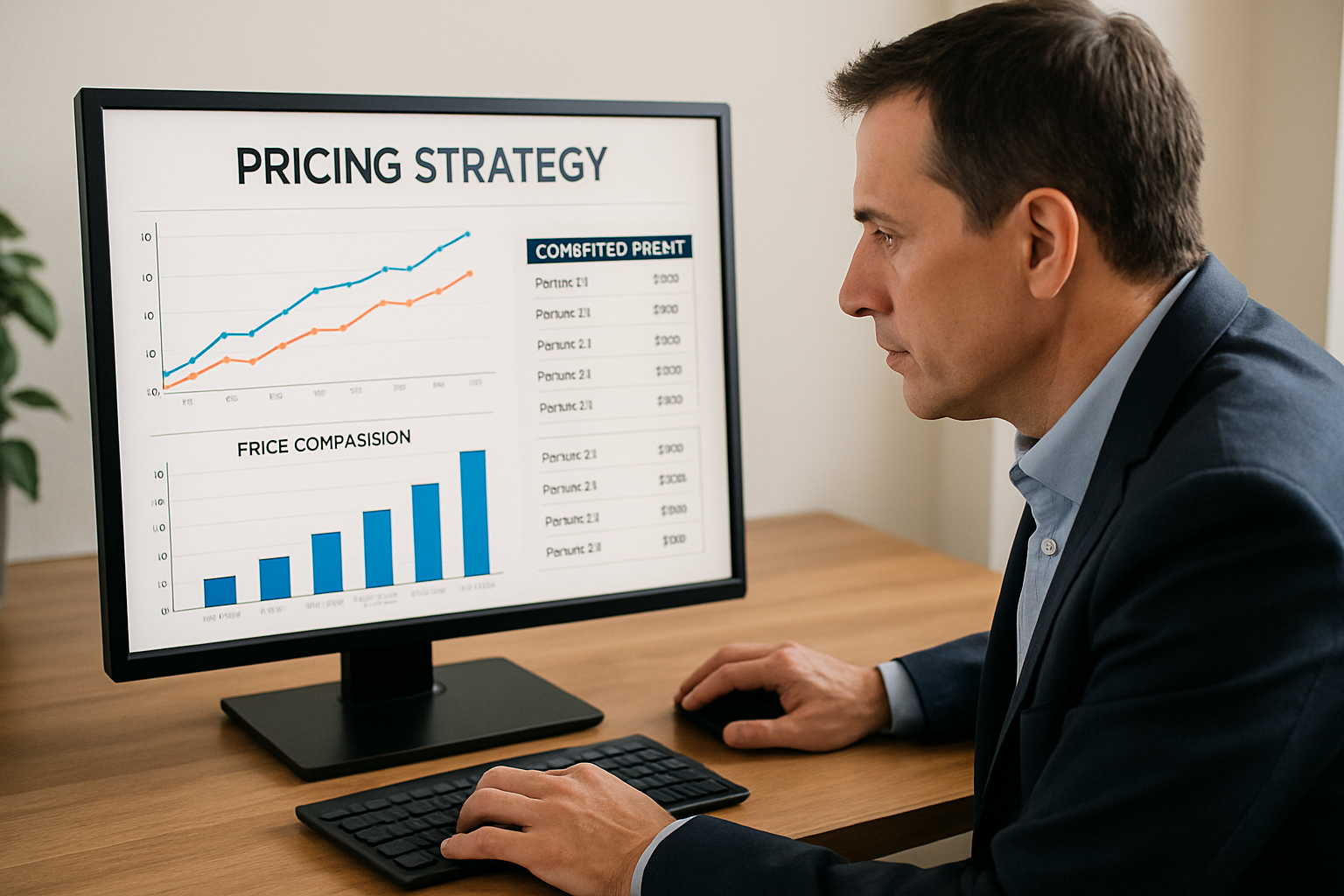In today’s fiercely competitive market landscape, setting the right price for your products or services can be the defining factor between thriving or merely surviving. Companies across industries face an ever-evolving challenge: how to price competitively without eroding profitability. This delicate balancing act involves not only understanding market dynamics and customer expectations but also keeping a vigilant eye on the competition. Recent studies by renowned consulting powerhouses like McKinsey & Company and Boston Consulting Group emphasize that nearly one-third of pricing decisions in businesses do not capture optimal value—highlighting a significant opportunity to refine pricing strategies.
Business leaders today are leveraging competitive pricing strategies to carve out distinctive market positions. A hands-on example involves an ice cream startup, ‘Frosty Delights,’ entering a saturated neighborhood. By benchmarking against established competitors selling premium scoops at $3.50, the startup calibrates its price at $3.25 to attract value-driven customers without sacrificing perceived quality. This fine-tuned approach exemplifies how price positioning deeply impacts market traction, brand perception, and ultimately profitability.
As organizations navigate the complexities of price setting, they also integrate insights from firms such as Deloitte, KPMG, Accenture, and Gartner, utilizing data-driven analyses and market intelligence to create adaptive, competitive pricing frameworks. Furthermore, emerging market trends in 2025 underscore the necessity of dynamic pricing strategies that flex in response to shifting consumer demands and competitor movements.
With this backdrop, we explore the multifaceted domain of establishing pricing strategies that offer a competitive edge, dissecting foundational concepts, advantages, pitfalls, and tactical implementations used by industry leaders and startups alike. Along this journey, we will uncover methodologies to not only set informed prices but also respond adeptly to marketplace flux, all while driving sustained business growth. Dive deeper to unlock practical insights and actionable tactics tailored for today’s global and highly competitive markets.
Understanding Competitive Pricing Strategy: Foundations and Market Impact
Competitive pricing strategy is fundamentally about positioning your product or service price relative to competitors, rather than solely focusing on production costs or perceived value alone. It offers businesses a market-oriented perspective that helps them stay relevant and responsive to consumer purchasing behavior.
Consider the wholesale cheese distribution niche, where companies operate in a fiercely contested marketplace. Each distributor closely monitors pricing trends set by others, intending to either align closely, undercut slightly, or strategically price higher to signal superior quality. For example, if Company A launches a gourmet cheese priced at $800, Company B might respond with a comparable product priced at $750, targeting price-sensitive buyers, while Company C might price their product at $850, banking on premium brand perception and exceptional service.
Such strategic calibration is not static; competitive pricing demands active monitoring and agility. This approach is distinct from cost-based or tiered pricing because the focus shifts from internal cost structures to external market realities. By mirroring competitors’ prices or responding with a differentiated pricing tactical stance, companies can better manage market share and customer loyalty.
- Market Monitoring: systematically tracking competitor prices and market trends.
- Price Positioning: deciding to match, beat, or exceed competitors’ prices based on brand strategy.
- Customer Segmentation: tailoring pricing to target groups, such as budget-conscious or premium buyers.
- Value Communication: ensuring pricing reflects perceived product benefits and quality.
| Pricing Strategy Type | Key Characteristics | Market Application | Example |
|---|---|---|---|
| Price Matching | Sets prices equal to competitors to stay on par. | Used in highly commoditized markets. | Retailers matching Amazon’s prices on electronics. |
| Penetration Pricing | Offers lower prices initially to capture market share. | New product launches or startups. | Streaming service offering discounted subscriptions at launch. |
| Premium Pricing | Prices above competitors to communicate exclusivity. | Luxury products and brands. | Boutique coffee brands charging a premium for unique beans. |
| Discount Pricing | Temporary low prices to drive short-term sales boosts. | Seasonal sales or inventory clearance. | Fashion retailers offering end-of-season discounts. |
Organizations like PricewaterhouseCoopers and Oliver Wyman advocate that embedding these pricing strategies within a comprehensive framework supported by market intelligence and analytics yields superior results. They emphasize combining competitive pricing with other strategic levers such as innovation and customer experience enhancement to avoid the pitfalls of mere price wars.

Key Benefits of Applying Competitive Pricing Strategies for Market Leadership
Adopting a competitive pricing strategy offers tangible benefits that directly influence business growth and market positioning. This strategy helps companies remain relevant and aligned with customer expectations, thus attracting and retaining a loyal base of consumers in an increasingly price-sensitive world.
One significant advantage is the ability to secure market share by appealing to consumers seeking a balance between price and quality. Competitive pricing often motivates increased sales volume, which can open doors to economies of scale and improved operational efficiencies—elements crucial to enhancing profitability.
Moreover, ongoing competitive price analysis provides critical market insights. Companies like Bain & Company and Accenture highlight how such intelligence reveals shifting consumer preferences and emerging market trends, enabling swift and informed adjustments in strategic pricing objectives.
- Improved Customer Acquisition: Lower or aligned prices attract new customers comparing alternatives.
- Customer Retention: Fair, competitive prices help build loyalty and trust.
- Scalable Profitability: Volume-driven sales, combined with efficient costs, increase profit margins.
- Strategic Market Insights: Timely adjustments boost responsiveness to consumer behavior.
- Innovation Incentives: Competitive pressures may drive enhancement in product quality or features.
- Negotiating Advantage: Competitive prices strengthen supply chain and retail partnerships.
| Benefit | Impact | Business Example |
|---|---|---|
| Market Positioning | Positions brand against competitors effectively. | A tech startup pricing competitively to disrupt incumbent players. |
| Sales Growth | Boosts volume and market penetration. | Retailer offering mid-range priced smartphones to capture price-conscious buyers. |
| Customer Loyalty | Enhances repeat purchases and advocacy. | Subscription-based SaaS platform with tiered competitive pricing. |
| Cost Control | Improves operational efficiency. | Manufacturing firm optimizing production to maintain margin at competitive prices. |
For businesses eager to boost bottom lines and gain a durable foothold in dynamic markets, implementing competitive pricing can be transformative. It’s not just about undercutting rivals but smartly balancing value, market demands, and company goals. To dive deeper into effective sales approaches and pricing mechanisms, resources such as this guide on sales funnel optimization provide valuable supplemental strategies.
Navigating Risks and Challenges in Competitive Pricing Strategy Implementation
While competitive pricing promises multiple benefits, it also carries inherent risks that businesses must carefully manage. Overemphasis on matching or beating competitors can erode profitability, weaken brand equity, and stifle innovation. Recognizing these challenges allows companies to calibrate their pricing approaches prudently.
Price wars are a prime concern in aggressive markets. When competitors continuously lower their prices to capture market share, this can trigger a race to the bottom, forcing all players into unsustainable margins. A classic example involves fast-food chains like McDonald’s and Burger King periodically engaging in such pricing duels to attract price-sensitive customers. While this may boost short-term sales, over time, it can damage brand perceptions and profitability.
- Reduced Margins: Intense competition may lead to prices dropping below sustainable levels.
- Brand Dilution Risks: Persistent low prices may signal inferior quality to customers.
- Reactive Pricing Culture: Excessive focus on competitor moves may curb strategic autonomy.
- Diminished Innovation Capacity: Limited profitability can reduce resources for R&D.
- Market Instability: Price volatility undermines overall market health.
| Challenge | Implication | Mitigation Strategy |
|---|---|---|
| Price Wars | Profit erosion and market instability. | Introduce product differentiation and focus on value-added services. |
| Brand Perception Decline | Customers equate low price with low quality. | Communicate unique value propositions and enhance customer experience. |
| Overdependence on Competitors | Loss of pricing strategy control. | Develop pricing models integrating internal cost and value data. |
| Short-Term Focus | Neglect of long-term growth and innovation. | Balance competitive pricing with investments in R&D and brand building. |
Consulting firms such as KPMG and Deloitte emphasize the importance of blending competitive pricing with broader strategic initiatives. These include leveraging technology for real-time pricing adjustments and building robust customer relationships that justify premium pricing, circumventing race-to-the-bottom scenarios.

Effective Tactics to Implement Competitive Pricing Strategies for Business Growth
Successful deployment of competitive pricing strategies hinges on selecting the right tactical approach based on market context, business goals, and customer segments. The spectrum of tactics offers flexibility for businesses to innovate their pricing model in line with evolving demands.
A few proven tactics include:
- Price Matching: Aligning prices exactly with competitors; widely used in retail environments to avoid customer loss.
- Penetration Pricing: Setting prices lower initially to rapidly capture market share; often used by SaaS startups as highlighted in recent SaaS startup analyses.
- Skimming Pricing: Launching at premium price to capitalize on early adopters, with gradual decreases; suitable for innovative tech products.
- Premium Pricing: Pricing above market rate to position products as luxury or top-tier options, built on unique value propositions.
- Discount and Bundle Pricing: Offering temporary discounts or product packages to enhance sales volume and customer perceived value.
- Value-Based Pricing: Tailoring prices to reflect the perceived customer value rather than solely production cost or competitor rates.
| Tactic | Business Impact | Use Case |
|---|---|---|
| Price Matching | Prevents loss of price-sensitive customers. | Retail chains matching e-commerce prices. |
| Penetration Pricing | Accelerates market share acquisition. | New SaaS platforms gaining initial users. |
| Skimming Pricing | Maximizes revenue from enthusiasts. | Cutting-edge electronics or gadgets. |
| Premium Pricing | Attracts niche segments valuing exclusivity. | Luxury fashion brands or artisanal products. |
| Discount Pricing | Boosts short-term sales, clears inventory. | Seasonal retail campaigns. |
Organizations like Gartner and Oliver Wyman recommend integrating competitive pricing strategies with advanced analytics and consumer data to enhance precision and responsiveness. Additionally, marketplaces leveraging strategies outlined in marketing technique guides can improve product visibility and optimize pricing simultaneously.
Leveraging Technology and Market Intelligence for Dynamic Competitive Pricing
The rapid advancement of technology in 2025 provides businesses with unprecedented tools to hone their competitive pricing strategies in real-time. Integrative pricing platforms, AI-powered analytics, and market intelligence services from leading firms such as Nielsen and McKinsey & Company empower businesses to respond swiftly and accurately to market fluctuations.
Dynamic pricing becomes increasingly accessible, where algorithms automatically adjust prices based on competitor moves, demand changes, and inventory levels. This is especially potent for e-commerce and SaaS sectors, where consumer behavior data is abundant and market shifts are frequent.
- Real-Time Market Scanning: Automated tools continuously analyze competitor prices and market trends.
- AI and Predictive Analytics: Machine learning predicts optimal price points for maximizing sales and margins.
- Integration with CRM and Inventory: Ensures pricing aligns with customer segmentation and stock availability.
- Price Optimization Models: Balances multiple variables such as cost, competition, and customer willingness to pay.
- Scenario Planning: Simulates pricing impact under various market conditions to support strategic decision-making.
| Technology/Tool | Purpose | Benefit |
|---|---|---|
| AI-Powered Pricing Engines | Dynamic price adjustments based on data. | Maximizes revenue in real time. |
| Competitive Market Intelligence Platforms | Monitors competitor pricing and offers. | Improves responsiveness and strategic positioning. |
| Customer Analytics Tools | Analyzes purchasing behavior and preferences. | Supports personalized pricing and targeting. |
| Inventory Management Integration | Aligns stock levels with pricing strategies. | Prevents overstocking and markdowns. |
Top consultancies such as PricewaterhouseCoopers endorse these technology-driven approaches, underpinning how digital transformation strengthens market competitiveness. For companies interested in scaling effectively, resources like analytics in marketing eBooks offer in-depth knowledge on leveraging data for pricing success.
Frequently Asked Questions About Competitive Pricing Strategy
- What are the primary types of competitive pricing strategies?
The main types include cost-based pricing, market-oriented pricing, and competition-based pricing, each focusing differently on costs, market conditions, and competitor prices. - Can competitive pricing lead to pricing wars?
Yes, while competitive pricing aims to align prices, aggressive undercutting can trigger price wars, which may harm profitability and market stability. - How can businesses avoid eroding profit margins with competitive pricing?
By balancing competitive pricing with value-added features, effective cost management, and tiered pricing models, businesses can protect margins while staying appealing. - Is technology necessary for competitive pricing strategy?
While not mandatory, using technology such as AI pricing tools and market intelligence platforms greatly enhances the ability to adjust prices quickly and optimally. - Where can I learn more about implementing competitive pricing strategies?
Resources like eBooks on concept-to-cash strategies and profitable ebook secrets offer comprehensive insights on pricing and sales techniques.


